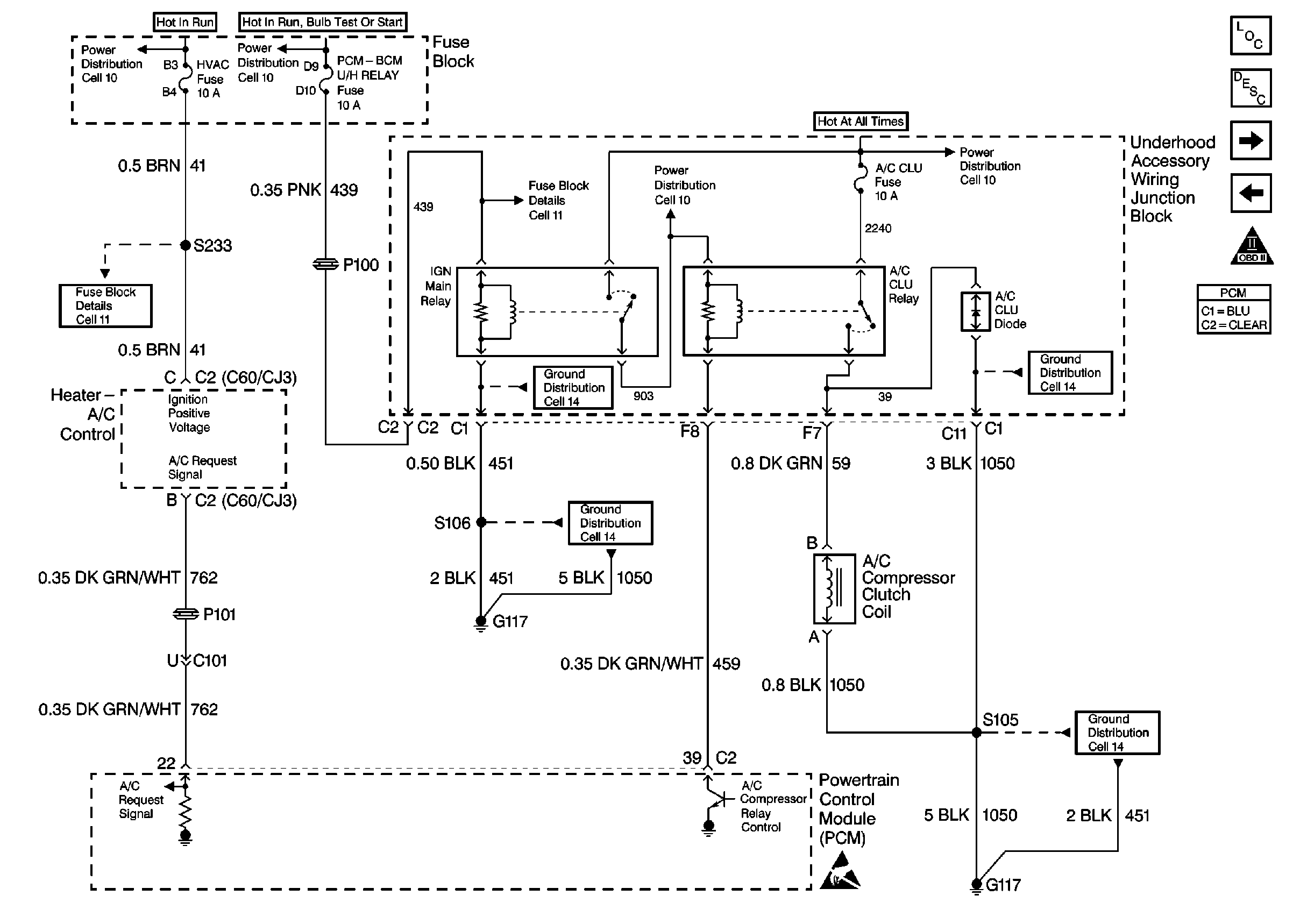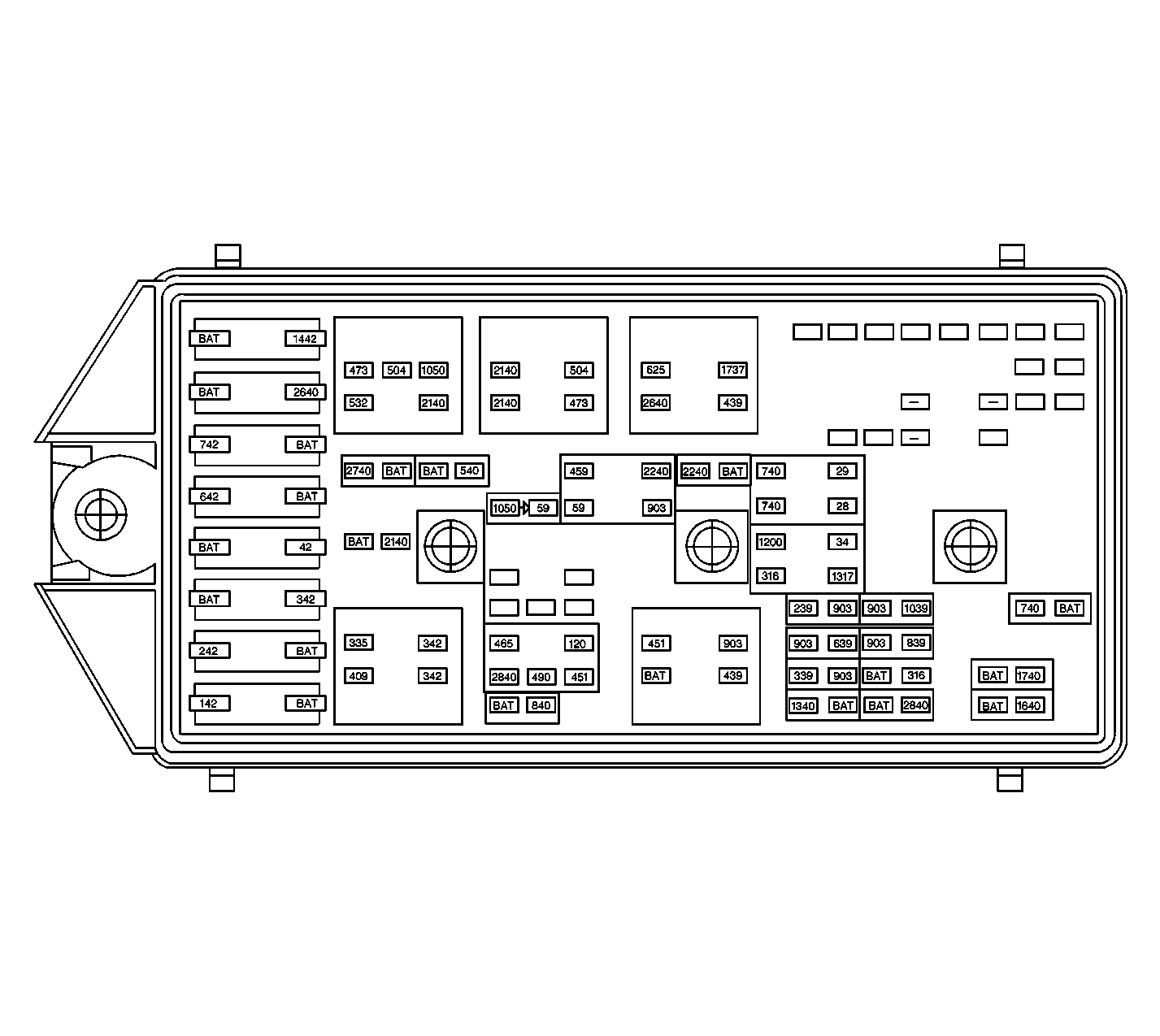| Table 1: | A/C Compressor Control Circuit Diagnosis (CJ2) |
| Table 2: | A/C Compressor Control Circuit (CJ3, C60) |
Refer to Engine Controls Schematics
Cell 20: A/C Compressor Controls

,
HVAC Compressor Control Schematics
in HVAC System-Manual, or
HVAC Compressor Control Schematics
in HVAC System-Automatic.
Circuit Description
When A/C is selected through the A/C controller a signal is supplied to the PCM through two different methods depending on the vehicle content. The first is by Class II serial data circuit (CJ2, and the second is by a 12 volt A/C request circuit to the PCM (CJ3, C60). The PCM monitors the A/C refrigerant pressure. If the A/C refrigerant pressure, and engine operating conditions are within a specific calibrated acceptable ranges the PCM will enable the A/C Relay. This is accomplished by providing a ground path for the A/C Relay coil within the PCM. When the A/C compressor relay is enabled battery positive voltage is supplied to the compressor clutch coil.
The PCM will enable the A/C compressor clutch whenever the engine is running and the A/C has been requested, unless any of the following conditions are met:
| • | Throttle greater than 96%. |
| • | A/C Pressure Sensor greater than 440 psi (4.6 volts) or less than 35 psi (0.35 volt) (as determined by the A/C Pressure Sensor). |
| • | Ignition voltage below 10 volts. |
| • | Engine speed greater than 4700 RPM. |
| • | ECT greater than 125°C (257°F). |
| • | IAT less than 5°C (41°F). |
| • | Class II communication error between the HVAC controller and the PCM (CJ2). |
| • | An open or a short to ground in the 12 Volt A/C request circuit (CJ3, C60). |
Diagnostic Aids
Inspect for the following:
Important: : Remove any debris from the connector surfaces before servicing a component. Inspect the connector gaskets when diagnosing or replacing a component. Ensure that the gaskets are installed correctly. The gaskets prevent contaminate intrusion.
| • | Poor terminal connection. |
| Inspect the harness connectors for backed out terminals, improper mating, broken locks, improperly formed or damaged terminals, and faulty terminal to wire connection. Use a corresponding mating terminal to test for proper tension. Refer to Intermittents and Poor Connections Diagnosis , and Connector Repairs Wiring Systems. |
| • | Damaged harness. |
| Inspect the wiring harness for damage. If the harness appears to be OK, observe the sensor display on the scan tool while moving connectors and wiring harnesses related to the sensor. A change in the sensor display may indicate the location of the fault. Refer to Wiring Repairs in Wiring Systems. |
| • | Inspect the PCM and the engine grounds for clean and secure connections. |
If the DTC is determined to be intermittent, reviewing the Fail Records can be useful in determining when the DTC was last set.
Step | Action | Values | Yes | No | ||||||||
|---|---|---|---|---|---|---|---|---|---|---|---|---|
1 | Was the Powerrtrain OBD System Test performed? | -- | ||||||||||
2 | Are any PCM or HVAC DTCs stored? | -- | Diagnose the applicable DTCs | |||||||||
3 |
Important: : The following conditions must be met before continuing with this step:
Is the A/C Clutch engaged? | -- | ||||||||||
4 |
Is the A/C clutch engaged? | -- | Refer to Diagnostic Aids | |||||||||
5 |
Does the A/C Request display YES? | -- | ||||||||||
6 | Observe the A/C pressure sensor display on the scan tool. Does the A/C pressure sensor indicate a voltage between the specified values? | 0.4V - 4.6V | Go to System Performance Test in HVAC System | |||||||||
7 |
Is high side refrigerant pressure within the specified values? | 35 psi - 440 psi | Go to VDOT A/C System Diagnosis in HVAC System | Go to DTC P0530 Air Conditioning (A/C) Refrigerant Pressure Sensor Circuit | ||||||||
8 | Inspect the A/C clutch fuse. Is the A/C cutch fuse blown? | -- | ||||||||||
9 |
Was a problem found? | -- | ||||||||||
10 |
Is the A/C clutch engaged? | -- | ||||||||||
11 |
Was a problem found? | -- | ||||||||||
12 |
Was a problem found? | -- | ||||||||||
13 |
Is the A/C clutch engaged? | -- | ||||||||||
14 | Disconnect the A/C clutch connector. Is the A/C clutch engaged? | -- | ||||||||||
15 | Replace the A/C clutch. Is the action complete? | -- | -- | |||||||||
16 | Replace the A/C relay. Refer to Compressor Relay Replacement in HVAC System. Is the action complete? | -- | -- | |||||||||
17 | Locate and repair the short to voltage in the battery positive feed circuit to the A/C clutch. Refer to Repair Procedures in Wiring Repairs in Wiring System. Is th action complete? | -- | -- | |||||||||
18 |
Important: : The following conditions must be met before continuing with this step:
Did the A/C clutch engaged and disengage? | -- | System OK |
Test Description
The numbers below refer to numbers on the Diagnostic Table:
The A/C compressor clutch should not be engaged with the engine running if an A/C mode is not selected at the control head.
-
Stored Diagnostic Trouble Codes (That may not illuminate the Malfunction indicator Lamp) may disable the A/C compressor. This Diagnostic Table may lead to improper diagnosis and replacement of good parts if Diagnostic Trouble Codes are present.
-
The A/C compressor clutch should apply within 3-6 seconds, if the conditions under the Notice have been met.
-
Checks for an A/C request signal from the A/C controller to the PCM.
-
Checks the ignition feed circuit to the A/C relay.
-
Determines whether the A/C relay or the circuitry is at fault.
-
Determines whether or not the PCM is turning the A/C relay on due to a false A/C request.
-
Isolates problem to the A/C control head or the PCM.
Step
| Action | Value(s) | Yes | No | ||||||
|---|---|---|---|---|---|---|---|---|---|---|
1 | Was the Powertrain OBD System Check performed? | -- | Go to A Powertrain On Board Diagnostic (OBD) System Check | |||||||
Are any PCM DTCs stored? | -- | Go to applicable DTCs | ||||||||
|
Important: : The following conditions must be met before continuing with this step:
Is the A/C Clutch engaged. | -- | |||||||||
4 |
Is the A/C compressor clutch engaged? | -- | Go to Diagnostic Aids | |||||||
5 | With Defrost or Max mode selected, monitor A/C Request on the scan tool. Does A/C Request display Yes? | -- | ||||||||
Does the voltage measure near the specified value? | B+ | |||||||||
7 |
Was a problem found? | -- | Go to A Diagnostic System Check | |||||||
8 |
Was a problem found? | -- | ||||||||
9 | Observe A/C refrigerant pressure display on the scan tool. Is indicated A/C pressure between the specified values? | 36 - 440 psi | ||||||||
10 |
Is high side refrigerant pressure within the specified values? | 36 - 440 psi | Go to System Performance Test in HVAC System | |||||||
11 |
Does the scan tool display an A/C Highside pressure at the specified value? | 0 psi | ||||||||
Is the J 35616-200 test lamp on? | -- | |||||||||
Connect
a fused jumper between the ignition feed circuit and A/C compressor clutch
control circuit at the A/C Relay in the
Does the A/C compressor clutch engage? | -- | |||||||||
14 |
Was a problem found? | -- | ||||||||
15 |
Is the J 35616-200 test lamp on? | -- | ||||||||
16 |
Was a problem found? | -- | ||||||||
17 |
Was a problem found? | -- | ||||||||
18 |
Does A/C Request display Yes? | -- | ||||||||
19 |
Does the voltage measure near the specified value? | B+ | ||||||||
20 |
If a problem is found, repair as necessary. Refer to Wiring Repairs . Was a problem found? | -- | Go to A Diagnostic System Check | |||||||
Is the A/C compressor clutch engaged? | -- | |||||||||
Locate and repair short to voltage in the A/C compressor clutch control circuit. Refer to Wiring Repairs . Is the action complete? | -- | -- | ||||||||
23 | Repair open or short to ground in ignition feed circuit to the A/C Relay. Refer to Wiring Repairs . Is the action complete? | -- | -- | |||||||
24 | Replace A/C Relay. Is the action complete? | -- | -- | |||||||
25 | Repair A/C compressor clutch. Is the action complete? | -- | -- | |||||||
26 | Locate and repair open in A/C compressor clutch ground circuit. Refer to Wiring Repairs . Is the action complete? | -- | -- | |||||||
27 |
Important: : The replacement PCM must be programmed. Replace the PCM. Refer to PCM Replacement/Programming . Is the action complete? | -- | -- | |||||||
28 | Replace A/C refrigerant pressure sensor. Is the action complete? | -- | -- | |||||||
29 |
Important: : The following conditions must be met before continuing with this step:
Is the A/C Clutch engage. | -- | System OK |

